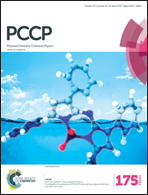A study of the impact of co-adsorbents on DSSC electron transfer processes: anti-π-stacking vs. shield effect†
Abstract
In this study we report a detailed exploration of the use of two different co-adsorbents – namely bis-methoxyphenylphosphinic acid (BMPP) and chenodeoxycholic acid (CDCA) – known to increase photoconversion efficiency (PCE) of DSSCs sensitized with N719. We have explored the variation of their abilities with the [co-ads]/[D] ratio of the sensitization bath in order to lower the intermolecular deactivations (anti-π-stacking effect) and recombinations between photo-injected electrons and the oxidized mediator (shield effect). EIS-λ technique has been used for this purpose, allowing the two effects considered here to be accurately quantified. DSSC containing BMPP allowed to improve the cell PCE by 60% with a ratio [co-ads]/[D] = 1, exhibiting a strong shield effect, while the maximum PCE obtained with CDCA was slightly over 7% (corresponding to 30% improvement) with a ratio [co-ads]/[D] = 10 and exhibiting a strong anti-π-stacking effect.


 Please wait while we load your content...
Please wait while we load your content...